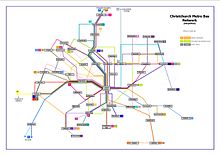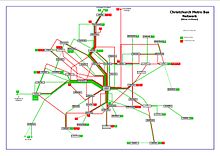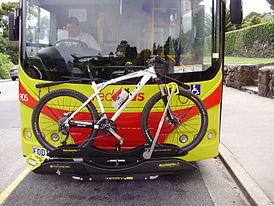- Public transport in Christchurch
-
Metro 
Locale New Zealand Service area Christchurch Service type Bus services Fuel type Diesel, biodiesel Operator Red Bus Ltd
Christchurch Bus Services Ltd
Leopard Coachlines Ltd
Black Cat Ltd[1]Web site metroinfo.org.nz Public transport in Christchurch, New Zealand consists of bus services operated by three bus companies (who win a renewable tender process) supported by a ferry, all jointly marketed as Metro.
Contents
Overview
Buses from the three different companies in Christchurch display not only their own company logo and livery but also the Metro logo to signal they are part of the citywide network. The Northern Star service has its own blue livery. A Selwyn Star service will feature a yellow livery. The City Flyer buses are excused from having the logo as part of a commercial agreement.
'Real-time' bus arrival times are displayed on electronic displays at bus stops, online and mobile (cellphone) WAP.
Ticketing and fares are, with some exceptions, standard across the city's network. An electronic 'Metro' card provides a discount off regular fares. Students receive a discount, and senior citizens travel free (a law from New Zealand's central government).
The 'Bus Exchange' in the city centre serves as the chief bus interchange point and passenger hub for the Metro network. The Exchange has attracted interest from other worldwide city authorities investigating how to improve their bus services. Since the Bus Exchange opened in 2000, the number of people using the bus service has doubled and numbers are still increasing. There is now a need to provide a larger Transport Interchange.
The City Council has purchased land for a new Transport Interchange in the block bounded by Colombo, Lichfield, Durham and Tuam Streets. The new facility will be able to accommodate more buses. It is expected to have 26 bus stands rather than the nine in the current exchange. It will be safer because people will not need to walk across where buses enter and exit. Manoeuvring of buses will take place underground and there will be a below ground central waiting lounge for travellers. The interchange will integrate with other modes of transport such as cycling, taxis, long distance coaches and shuttles, car parking and in the future, light rail. As a result of the September 2010 and February 2011 earthquakes the Council has deferred some capital projects, including the new bus exchange, to focus resources on more urgent priorities.[2] The current bus exchange building has been condemned[3] and a temporary exchange is currently under construction at the site acquired for the new exchange.[4]
Bus lanes operational during peak commuting hours have now opened on some routes. These were opened because traffic congestion was causing delays to services and discouraging commuters from using buses as an alternative to private motor vehicles. The routes have been controversial with some business owners concerned at the loss of parking from outide their businesses during the lanes operational times, but the lanes have improved bus travel times, schedule adherence and have resulted in an increase in passenger numbers. More bus lanes are proposed on other busy routes.
In early 2010 the Christchurch City Council published "A City for People Action Plan" based a 2009 study by Jan Gehl, renown urban designer and city planner, with his recommendations into improving life in the city. The chief recommendation was to improve facilities for pedestrians and cyclists. As part of this the number of bus routes travelling down the city's main street, Colombo Street, would be reduced. The majority of buses would travel an inner city ring route instead.[5]
Suburban bus services
The new Central Station replaced the two temporary bus exchanges which had replaced the city's damaged Bus Xchange. The new exchange is located between Lichfield Street and Tuam Street and will operate for up to two years. The Link Shuttle service which linked the two temporary exchanges has now been terminated.
The following services are operated under the Metro brand.
# Route Start End Timetable Notes C Comet Hornby via Airport Papanui [1] 
M Metrostar Halswell via Hornby New Brighton [2] O Orbiter Circuit route through suburban shopping centres [3] 3 Sumner to Airport Sumner via City & Avonhead Airport [4] 
5 Hornby to Southshore Hornby via City & New Brighton Southshore [5] 
7 Halswell to Queenspark Halswell via City Queenspark [6] 
8 Hoon Hay to Casebrook Hoon Hay via City Casebrook [7] 9 Wairakei City via Bryndwr Burnside [8] 10 Airport to Cashmere Airport via City Cashmere [9] 11 Westmorland to Styx Mill Westmorland via City Styx Mill [10] 
12 Murray Aynsley to Northwood Murray Aynsley via City & Cashmere Northwood [11] 14 Dyers Pass to Harewood Dyers Pass via City Harewood [12] 
15 Bishopdale to Beckenham Bishopdale via City Beckenham [13] 
16 Belfast City via Papanui Belfast [14] 18 St Albans to Huntsbury Papanui via City Huntsbury [15] 
20 Barrington to Burnside Barrington via City Burnside [16] 21 Ilam to Mt Pleasant Ilam via City Mount Pleasant [17] 
22 Spreydon to Redwood Spreydon via City Redwood [18] 23 Hyde Park to Woolston Hyde Park via City Woolston [19] 28 Lyttelton & Rapaki City via Heathcote Lyttelton & Rapaki [20] 
29 Airport City via Fendalton Airport [21] 40 Middleton to Wainoni Middleton via City New Brighton [22] 45 North Shore City via Shirley North Shore [23] 
46 Marshland City via Shirley Marshland [24] 
60 Parklands City via Parklands New Brighton [25] 81 Lincoln City via Riccarton Lincoln [26] 
83 Hei Hei City via Riccarton & Hei Hei Hornby [27] 
84 Russley City via Riccarton & Russley Hornby [28] 
88 Rolleston City via Riccarton & Templeton Rolleston [29] 
90 Rangiora City via Papanui & Kaiapoi Rangiora [30] 
92 Rangiora via Woodend and Waikuku City via Papanui, Woodend & Waikuku Rangiora [31] 
480 Kainga Shirley via Spencerville Kainga [32] 535 Lyttleton Eastgate Link Lyttleton via Heathcote Linwood [33] 820 Burnham to Lincoln Burnham via Rolleston Lincoln [34] 
912 Woodend Shuttle Rangiora via Woodend Kaiapoi [35] 913 Woodend Shuttle via Waikuku Rangiora via Woodend & Waikuku Kaiapoi [36] Key
- ll Route operated by Red Bus
- ll Route operated by Leopard Coachlines
- ll Route operated by Go Bus Christchurch
Bikes on buses
Christchurch is currently the only place in New Zealand where bikes are carried on suburban buses. The trial started in November 2007 on the 35 route to Heathcote.[6] Bike racks on buses are provided on many routes now.
The Shuttle
The Shuttle is a zero-fare Public transport service in the inner city.[7] The hybrid buses, which are battery powered using a small Liquefied petroleum gas-fuelled gas turbine engine to keep the battery charged, produce less air pollution than normal diesel buses[citation needed]. The Shuttle's fleet of (yellow) hybrid buses is operated by Red Bus Ltd[7] and the service is funded by Christchurch City Council.[8]
Other transport services
Taxis
There are a variety of taxi operators active in Christchurch. Operations are regulated by the New Zealand Transport Agency.
Airport transport
Christchurch International Airport is served by buses and shuttle vans.
- Three bus routes are available from the airport bus stand located outside the International Arrivals Terminal;
- the number 3 bus (via Avonhead & City to Sumner)
- the number 10 bus (via Harewood & City to Cashmere)
- the number 29 bus (via Fendalton to City)
- One bus route is available at the entrance to the airport car park (5 minute walk from terminals) on Orchard Road and Memorial Avenue;
- the Comet (Hornby to Papanui via Airport)
- Shuttle vans provided by several operators, including most taxi companies, provide door-to-door transport to and from the Airport.
Diamond Harbour ferry
A ferry connects the suburb of Lyttelton to Diamond Harbour, a settlement on the opposite side of Lyttelton Harbour. Ferries first began crossing Lyttelton Harbour in 1888. The ferry is operated by Black Cat Ltd.
Christchurch Tramway
Main article: Trams in ChristchurchChristchurch Tramway Ltd [37] operates a one-way tram circuit of the central city. This is mainly marketed as a tourist attraction, but is available to local commuters with an annual season ticket. Trams were originally introduced to Christchurch in 1905, ceased operating in 1954,[9] and returned to the newly-built inner city loop in 1995, mainly as a tourist attraction.
Preliminary investigation into light rail options for Christchurch have begun. Investigating options and protecting possible routes is an action point in the City Council's "A City for People Action Plan" (approved in 2010). The new Transport Interchange is being designed to accommodate a future light rail network.
Heavy rail
Main article: Rail transport in ChristchurchCommuter rail service was discontinued in the 1970s, while long distance rail travel (by Tranz Scenic) has been scaled back to just TranzCoastal and TranzAlpine, which leave from an architecturally controversial station in Riccarton.
Operations
The local bus service (with the exception of The Shuttle) is marketed as Metro and designed, specified, put out to tender and subsidised by Environment Canterbury.
Christchurch City Council provides roading infrastructure and street furniture such as signs and seats and regulates parking at bus stops, and is also owner of Red Bus Ltd through its holding company Christchurch City Holdings. The city council also fully funds the zero-fare The Shuttle service. The city council provided the current central city Bus Exchange in November 2000.
Vehicle safety standards are regulated by the New Zealand Transport Agency.
Cultural references
Christchurch's public transport system served as backdrop for Tim Veling's 2006 book "Red Bus Diary", in which the author toured the city on public buses and compiled the stories of the people he met.
References
- ^ http://www.metroinfo.org.nz/about_us.html Transport operators
- ^ SACHDEVA, SAM; JOHN HARTEVELT (1 April 2011). "Council braces for less money". The Press (Christchurch: Fairfax New Zealand). http://www.stuff.co.nz/the-press/news/christchurch-earthquake-2011/4834874/Council-braces-for-less-money. Retrieved 1 April 2011.
- ^ "Bus Exchange among nearly 600 condemned buildings". The Press (Christchurch: Fairfax New Zealand). 4 August 2011. http://www.stuff.co.nz/the-press/news/christchurch-earthquake-2011/5389665/Bus-Exchange-among-nearly-600-condemned-buildings. Retrieved 5 August 2011.
- ^ WRIGHT, MICHAEL (11 August 2011). "Quake law to be used on bus hub". The Press (Christchurch: Fairfax New Zealand). http://www.stuff.co.nz/the-press/news/christchurch-earthquake-2011/5425731/Quake-law-to-be-used-on-bus-hub. Retrieved 11 August 2011.
- ^ Gehl, Jan (2010). "Jan Gehl Public Space Public Life Study (Christchurch 2009, Public Space Public Life)". Christchurch City Council. http://www.ccc.govt.nz/cityleisure/projectstoimprovechristchurch/publicspacepubliclifestudy/index.aspx. Retrieved 19 February 2010.
- ^ "Bike-carrying racks on more bus routes from November". Christchurch: Environment Canterbury. 2009-01-29. http://www.ecan.govt.nz/news-and-notices/news/pages/bike-carrying-racks-more-bus-routes-November.aspx. Retrieved 8 February 2010.
- ^ a b Shuttle timetable on Christchurch City Council's christchurch.org website, retrieved 2009-08-09
- ^ http://www.metroinfo.org.nz/docs/Shuttle_web.pdf Shuttle pamphlet; accessed 20 Dec 2009
- ^ A Wheel on Each Corner, The History of the IPENZ Transportation Group 1956-2006 - Douglass, Malcolm; IPENZ Transportation Group, 2006, Page 12
External links
- Red Bus website
- Metro website
- Diamond Harbour ferry website
- MetroMate website - application for finding your bus stop and obtaining realtime information of the bus(s) coming
- NZ In Tranzit Blog - Commentary & advocacy articles about transit in Christchurch & NZ
Bus transport in New Zealand Urban bus companies Go Bus Transport (Go Bus Christchurch) · NZ Bus (GOWest - Northstar - The Link - Metrolink - Waka Pacific - GOWellington - Valley Flyer) · Leopard Coachlines Ltd · Passenger Transport · Red Bus Ltd · Ritchies Transport · Souter Holdings (Howick & Eastern - Mana Coach Services - Newlands Coach Services)Long distance bus companies Tourism bus companies Bus manufacturers Government and regulation History Infrastructure Categories:- Public transport in New Zealand
- Transport in Christchurch
- Transit authorities with hybrid buses
- Transit authorities with natural gas buses
- Cycling in New Zealand
Wikimedia Foundation. 2010.







